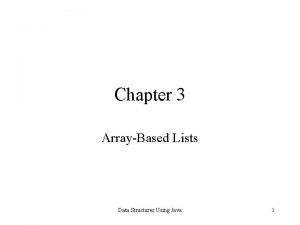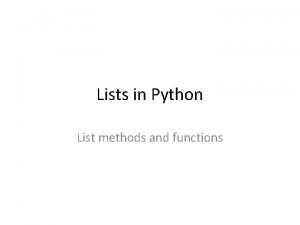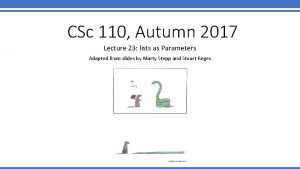CSc 110 Autumn 2016 Lecture 24 Lists of



![List of lists mystery def mystery(data, pos, n): result = [] for i in List of lists mystery def mystery(data, pos, n): result = [] for i in](https://slidetodoc.com/presentation_image_h2/8da0f7ba9dfbd9c9a6f701e4d4fb6014/image-4.jpg)

![Creating Lists of lists • list = [[0] * 4] * 5 will NOT Creating Lists of lists • list = [[0] * 4] * 5 will NOT](https://slidetodoc.com/presentation_image_h2/8da0f7ba9dfbd9c9a6f701e4d4fb6014/image-6.jpg)


- Slides: 8

CSc 110, Autumn 2016 Lecture 24: Lists of Lists

Mountain peak Write a program that reads elevation data from a file, draws it on a Drawing. Panel and finds the path from the highest elevation to the edge of the region. Data: 34 76 87 9 34 8 22 33 33 33 45 65 43 22 5 7 88 0 56 76 76 77 4 45 55 55 4 5 … This data is a different shape. How should we store it?

Lists of lists • You can put a list in a list = [[1, 2, 3], [4, 5, 6]] How can you access 2? list[0][1] How can you find the length of the second inner list ([4, 5, 6])? len(list[1])
![List of lists mystery def mysterydata pos n result for i in List of lists mystery def mystery(data, pos, n): result = [] for i in](https://slidetodoc.com/presentation_image_h2/8da0f7ba9dfbd9c9a6f701e4d4fb6014/image-4.jpg)
List of lists mystery def mystery(data, pos, n): result = [] for i in range(0, n): for j in range(0, n): result. append(data[i + pos][j + pos]) return result Suppose that a variable called grid has been declared as follows: grid = [[8, 2, 7, 8, 2, 1], [1, 5, 1, 7, 4, 7], [5, 9, 6, 7, 3, 2], [7, 8, 7, 7, 7, 9], [4, 2, 6, 9, 2, 3], [2, 2, 8, 1, 1, 3]] Function Call Contents of List Returned which means it will store the following 6 -by-6 grid of values: 8 2 7 8 2 1 mystery(grid, 2, 2) ______________ 1 5 1 7 4 7 5 9 6 7 3 2 mystery(grid, 0, 2) ______________ 7 8 7 7 7 9 4 2 6 9 2 3 mystery(grid, 3, 3) ______________ 2 2 8 1 1 3 For each call at right, indicate what value is returned. If the function call results in an error, write error instead.

Mountain peak Write a program that reads elevation data from a file, draws it on a Drawing. Panel and finds the path from the highest elevation to the edge of the region. Data: 34 76 87 9 34 8 22 33 33 33 45 65 43 22 5 7 88 0 56 76 76 77 4 45 55 55 4 5 …
![Creating Lists of lists list 0 4 5 will NOT Creating Lists of lists • list = [[0] * 4] * 5 will NOT](https://slidetodoc.com/presentation_image_h2/8da0f7ba9dfbd9c9a6f701e4d4fb6014/image-6.jpg)
Creating Lists of lists • list = [[0] * 4] * 5 will NOT create a list of lists • This will create a list with 5 spots that all contain the SAME list that is 4 long. • Instead, write the following: list = [] for i in range(0, 5): list. append([0] * 4)

Days till • Write a function called days_till that accepts a start month and day and a stop month and day and returns the number of days between them call days_till("december", 1, "december", 10) days_till("novembe. R", 15, "december", 10) days_till("OCTober", 6, "december", 17) days_till("october", 6, "oc. Tober", 1) return 9 25 72 360

Days till solution def days_till(start_month, start_day, stop_month, stop_day): months = (('january', 31), ('february', 28), ('march', 31), ('april', 30), ('may', 31), ('june', 30), ('july', 31), ('august', 31), ('september', 30), ('october', 31), ('november', 30), ('december', 31)) if start_month. lower() == stop_month. lower() and stop_day >= start_day: return stop_day - start_day days = 0 for i in range(0, len(months)): month = months[i] if month[0] == start_month. lower(): days = month[1] - start_day i += 1 while months[i % 12][0] != stop_month. lower(): days += months[i % 12][1] i += 1 days += stop_day return days















